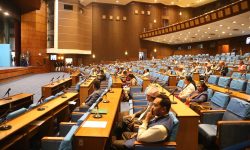‘Mega Planning’ in Ramagrama
Seeking the help of international organizations to enhance the priceless monument's aesthetic appeal

Ramagrama Stupa is located 50 km east of Lumbini, the birthplace of Lord Siddhartha Gautama Buddha, the harbinger of peace. On the other hand, Ujaini village-which can be accessed by traversing a distance of roughly 3 kilometers of the South Maheshpur road section from Parasi, the West Nawalparasi headquarters-is 15 minutes’ walk from Ramagrama Stupa.
In Ramgram municipality-7, there is a green hill known as Ramgram Stupa that can be seen on a level plain along the Jharahi River. This stupa symbolizes a priceless Buddhist religious and cultural hub. Through the fusion of several plant species, the verdant mound of Ramgram Stupa, studded with centuries-old Bodhi trees, represents unity and harmony in Buddhist teachings.
The main feature of the stupa region is thought to be the lovely garden in front and the thatched path made around it. Buddhist religious beliefs state that the Koliya king constructed the Ramagrama Stupa approximately 2,500 years ago. After the death of Gautam Buddha in Kushinagar, he was cremated there, and his relics were divided into eight parts, among which one stupa was built in Ramagrama.
There is also folklore about the stupa. After building the stupas containing the relics of Buddha, the place became the center of pilgrimage and devotion. When Ashoka was converted to Buddhism after the War of Kalinga, he made pilgrimages to different sites related to Buddha and his life. Beside visiting the pilgrimages, Ashoka thought to open all the stupas containing the relics of Buddha, distribute them in 84,000 parts, and rebuild a stupa on each of them as well. Thus, he opened seven of the original eight stupas, but when he arrived in Ramagrama to open the eighth, he found that the stupa was being guarded by the serpent king. On the persuasion of the serpent king, Ashoka did not dare to open the stupa. Due to which the sanity of the place is believed to be preserved. Unfortunately, being one of the major Buddhist pilgrimage sites, Ramagrama has long been neglected. However, there has been a rise in the number of foreign and domestic tourists who are interested in studying Buddhism for a while now.
Ramagrama is part of the Greater Lumbini concept, although it does not yet have a catchy tagline to distinguish itself. This could be because Ramagrama has been associated with a negative metaphor. The place was not in the limelight for a long time, not having a strategy for growth and development. People visiting the place for the first time probably feel nasty.
To cherish it now, Ramagrama is making an effort to convey a positive message by progressively eliminating the negative connotation given to the place. Plans to renovate the landscape of Ramagrama with architectural beauties are set to be carried out; this will not only transform the place’s aesthetic value but also bring a new identity to the place.

In Nepal, Ramagrama Stupa is a significant Buddhist pilgrimage site. This is the only original stupa constructed with the remnants of Buddha’s relics. Buddha artifacts have not been dug up from this location. As a result, pilgrims and disciples of the Buddha travel from all over the world to this sacred area to honor and revere the Buddha. “Now is the most important time to develop this holy place,” says Nikesh Adhikari, president of The Promise Land, which was established to transform the potential of Ramagrama. “Every year, the number of tourists visiting this place is increasing. Basic amenities are necessary for pilgrims. They truly require it. We wish to preserve this priceless monument. We will seek the help of individuals or international organizations to do it.”
The mammoth planning for Ramagrama has now begun. The 24-year-old Nikesh Adhikari is putting in a lot of effort to carry out this ambitious project, which was introduced in the Ramagrama area by the prime minister, Pushpa Kamal Dahal.

Ramagrama Municipality and Lumbini Development Fund are prepared to put a brick in it. It’s encouraging to hear of Nikesh’s intention to incorporate Ramagrama into a bigger endeavor, as this is a very significant spiritual field. “The time to develop Ramagrama is now,” says Nikesh. “We are putting some effort into it. We must all work together to accomplish this.
The Promise Land is attempting to enhance the beauty, religious importance, and development of Ramagrama through a broader initiative, reasoning that planned development is smarter than partial construction.
The goal of this new initiative is to restore the Ramagrama Stupa, a site of particular significance for Buddhism, in Nepal. According to Stefano Boeri, the project’s architect, “working in collaboration with local stakeholders and following UNESCO guidelines for heritage conservation, this initiative seeks to respect and preserve this historic and spiritual site while creating a space for prayer, meditation, and peaceful contemplation.”
Project architect Boeri further emphasizes that the architectural design guides visitors through a series of areas that highlight the stupa’s significance in an effort to ensure its sustained maintenance. It has imposing gateways that indicate the cardinal directions as well as a “peace meadow” that is intended for introspection. There are cultural landmarks and places for meditation all around this area, and there are also lush, biodiverse gardens.
The Lumbini Development Fund and Ramagrama Municipality have declared their support for The Promise Land in order to further this concept. The Promise Land and Lumbini Development Fund have also come to an agreement to move the project forward.
“Not only Lumbini, but many places in the Greater Lumbini area need to be made known to the world,” Vice President of the Lumbini Development Fund Lharkyal Lama said. “For the development and prosperity of Lumbini and the entire Ramagrama area, the Lumbini Development Fund and The Promise Land have reached an agreement. There will be a revolution in the growth and prosperity of this area as a result of this.”
The mayor of Ramagrama Municipality, Dhanapat Yadav, is likewise overjoyed that the overall Ramagrama development project is moving forward. On the day of the comprehensive Ramagrama master plan’s introduction, the municipality declared a public holiday. The municipal government has also established the Ramagrama Development Fund. The mayor is also looking forward to a budget from the central government for the development of the area.
The Ramagrama project should have a thorough master plan from the federal government and be recognized as a national pride project. Its subterranean physical safety needs to be guaranteed and preserved. Similar to the national-level program held in Lumbini, this program ought to take place here (in Ramagrama). Information about the project needs to reach a wider audience. “The sacred place has been eclipsed because of no proper attention from the federal and provincial governments,” says the mayor, Yadav, of the Ramagrama municipality. “At this point, assistance and collaboration are required for Ramagrama’s growth and promotion. The government and the Lumbini Development Fund ought to take the lead in attracting visitors to Lumbini to visit Ramagrama as well.
How would the master plan work ?
The Ramagrama Master Plan features a conceptual plan that has been designed and launched. A Heritage Area Impact Assessment (HIA) will now take place during the first phase. The stupa area of the Ramagrama area is now only 300 meters. However, The Promise Land, the organization spearheading the effort to reshape Ramgram, is getting ready to carry out a HIA in a two-kilometer radius surrounding the stupa location. The staff of the Lumbini Development Fund, UNESCO representatives, and the Department of Natural Resources team will conduct the survey from the drone, according to Nikesh Adhikari, president of The Promise Land. “We will also use other gadgets while conducting the survey. The HIA will take roughly four months to finish,” Adhikari said. According to Promise Land’s President Adhikari, a detailed project report (DPR) will be prepared following the completion of the HIA. “We don’t begin DPR until we complete HIA.”
In order to expand the project as a tourist destination, there are also plans to acquire 117 bighas of land in the Ramagrama area, which is now under the preview of individuals. The land will be purchased and registered under the Lumbini Development Fund’s name. The land acquisition is expected to cost 1 arba 50 crore, while the building of the area’s physical infrastructure is expected to cost 5 arba rupees.
No structures will be erected in the 300-meter zones in the Stupa area and the place where ‘Deep Prajjawalan’ (lighting lamp) is during project construction. However, four stupas will be constructed in four corners. In the vicinity of the stupa is a plan to construct a meditation center with viharas from sixteen different nations. The entire area is planned to be greened so that pilgrims can sit and light the lamp.
The man behind the map of the master plan

Architect Stefano Boeri has done the master plan for the Ramagrama stupa. Boeri is a renowned architect and an urban planner. He has done beautiful architectural mapping on many international-level projects.
Boeri has also carried out the reconstruction work in various places. He also designed the architecture of mid-Italy, which was devastated by the 6.2-magnitude earthquake on August 24th, 2016.
A 67-year-old Boeri whose office is located in Shanghai, China, and Tirana, the capital of Albania, has designed the Expo-2015 master plan, which was held in Milan, Italy. In addition, he has previous experience serving as a member of the Expo’s Architecture Council. It is he who has completed the exquisite mapping of Ramagrama’s master plan.
While most people associate religious sites with temples, churches, or other structures, Ramagrama is an especially revered and significant location. Buddha’s relics are kept here in a sacred location. It has a plain tumulus covered in grass with a plain yet unusual tree atop it.
“Keeping in mind both its religious and historical significance, it is sought to preserve such a site while promoting its spirit in a tangible yet subtle way,” Boiri states. “This important piece of Buddhism and history is turned into a biodiversity garden by such a plan, which has the appearance of a scene from a fantasy film. I view the opportunity to design this kind of endeavor as a privilege.”.








 गाजामा पिउने पानीको संकट
गाजामा पिउने पानीको संकट ५२ संवैधानिक नियुक्तिविरूद्धको रिट हेर्दाहेर्दैमा
५२ संवैधानिक नियुक्तिविरूद्धको रिट हेर्दाहेर्दैमा जनताको पक्षमा हुनेगरी संविधान संशोधन गर्न आवश्यक : अध्यक्ष प्रचण्ड
जनताको पक्षमा हुनेगरी संविधान संशोधन गर्न आवश्यक : अध्यक्ष प्रचण्ड युद्धविरामका लागि रुस प्रतिबद्ध भएमा युक्रेन वार्ताका लागि ‘तयार’: जेलेन्स्की
युद्धविरामका लागि रुस प्रतिबद्ध भएमा युक्रेन वार्ताका लागि ‘तयार’: जेलेन्स्की सगरमाथा संवादका लागि भारतबाट १५ विद्युतीय गाडी सहयोग
सगरमाथा संवादका लागि भारतबाट १५ विद्युतीय गाडी सहयोग भारतको पञ्जाव प्रान्तमा पनि विस्फोट
भारतको पञ्जाव प्रान्तमा पनि विस्फोट क्रिकेट छाडेर धाेनी पाकिस्तानसँग युद्दमा जानु पर्ने भएको हो ?
क्रिकेट छाडेर धाेनी पाकिस्तानसँग युद्दमा जानु पर्ने भएको हो ? भारत-पाकिस्तान तनावले उग्ररुप लिएपछि सीमा क्षेत्रमा थप कडाइ, सुरक्षा निकाय ‘हाइ अलर्ट’मा
भारत-पाकिस्तान तनावले उग्ररुप लिएपछि सीमा क्षेत्रमा थप कडाइ, सुरक्षा निकाय ‘हाइ अलर्ट’मा आज कति छ सुनकाे भाउ ?
आज कति छ सुनकाे भाउ ? भारत-पाकिस्तान तनाव : आईपीएलका बाँकी सबै खेल स्थगित
भारत-पाकिस्तान तनाव : आईपीएलका बाँकी सबै खेल स्थगित
प्रतिक्रिया